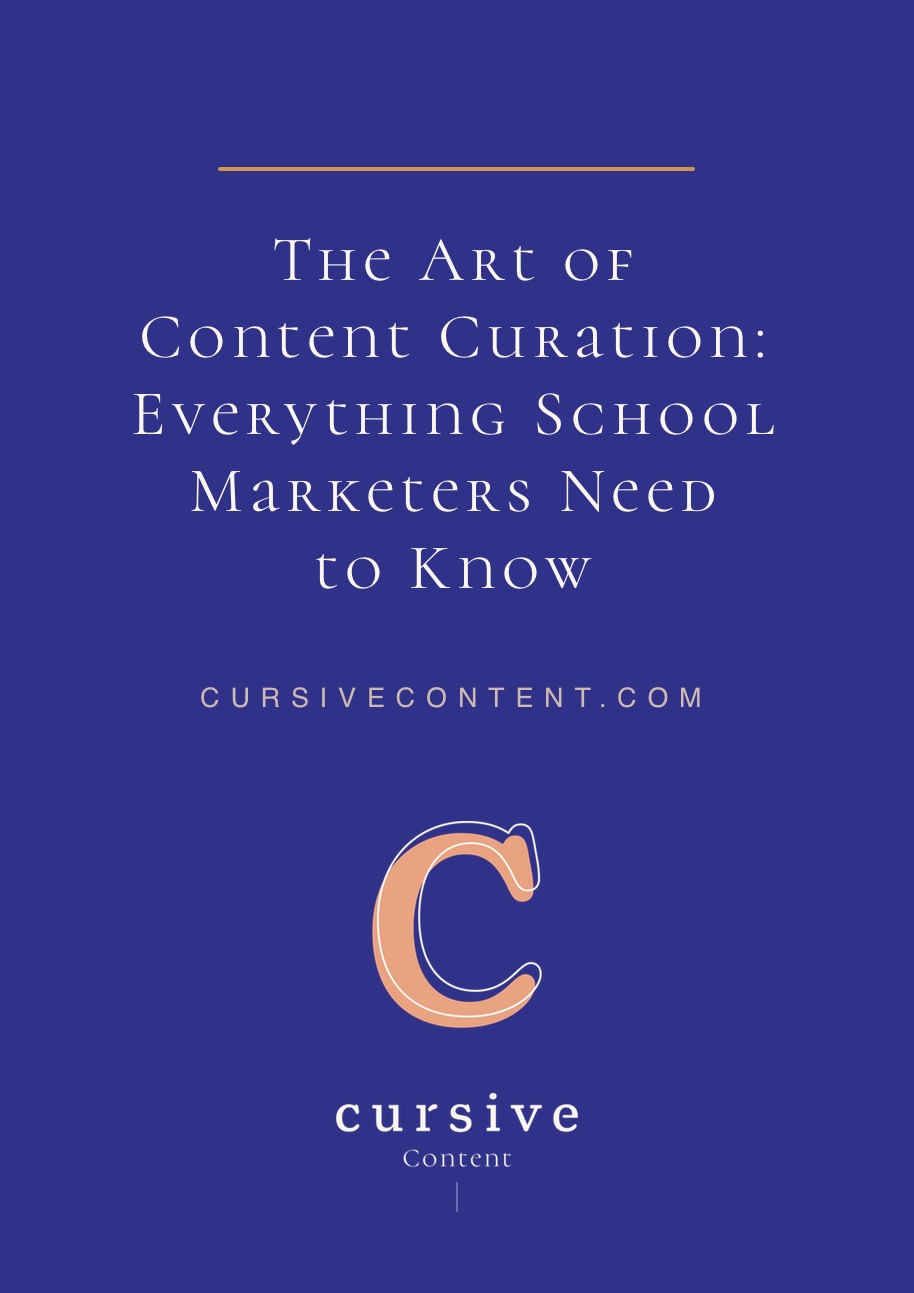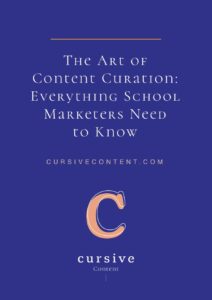Content Curation: Everything School Marketers Need to Know

For many school marketers, the thought of adding “content creation” to their team’s (or their own) to-do list is enough to cause a hive breakout.
But in reality, school storytelling doesn’t have to be overwhelming, and it’s not an all-or-nothing concept.
The key to making strong school storytelling a reality for your school is developing a smart strategy ahead of time – and part of that strategy may include adding content curation to your content mix.
Here is everything you need to know about why you should curate content and how to do it efficiently, along with when and where to use curated content.
WHAT IS CONTENT CURATION?
Content curation means actively searching, finding and sharing third-party content with your audience that it finds interesting, entertaining and trustworthy. You know what your audience wants and needs, and you’re sifting through the sand to uncover the gems that they would find valuable, relevant and meaningful. By doing so, you’re positioning yourself as a trusted resource that is in touch with the wants, needs and dreams of its students and families.
Here’s another content curation definition, from Beth Kanter:
“Content curation is the process of sorting through vast amounts of content on the web and presenting it in a meaningful and organized way around a specific theme.”
“Content curation” is such a fantastic term, isn’t it? It immediately brings to mind a fabulous art gallery with a collection of works by amazing artists.
Which is actually quite apropos.
“Unlike automated services (such as Google News), the essential difference of curation is that there’s a human being doing the sifting, sorting, arranging, and publishing. Just as a museum curator must decide which artifacts to display during an exhibition, an online curator decides what information available online is appropriate and relevant to her audience.” – Sean Carton
So, in a way, content curation does create a beautiful gallery—one that becomes a mighty tool in your content marketing.
It is not a hands-off, fool-proof process, but it is an approach that can add a lot of value to your content.
WHY YOU NEED CONTENT CURATION
Content curation allows you to maintain your school’s blog, email, social media and any other content you produce by pulling from a third-party source.
Content curation can:
- Save time—You aren’t creating as much of the content from scratch
- Make you more helpful & trustworthy—You are providing a variety of facts and opinions, not just your own
- Position you as a resource—Once people see that you are on top of the latest news, trends and topics, they’re more likely to refer to you for information on a topic
SHOULD YOUR SCHOOL USE CURATED CONTENT?
If you’re a busy school marketer who produces content, content curation will be helpful to you.
Once you have a process in place for curating content (which we’ll talk about next, and I promise—it’s simple) it will be easier for you to keep up with publishing content on a regular basis.
And since consistency is one of the keys to content marketing success, content curation can quickly become one of your most helpful tactics. It simplifies and improves the content creation process, but there is still work involved in the process of curating the content and adding your own thoughts. There is no true shortcut that will bring you an engaged audience who loves your content and your school.
HOW TO CURATE CONTENT
The best way to get started with content curation is to think about your content’s focus, then turn to the resources you already use.
This ensure that you are only curating from resources that are relevant to the topics your audience expects from you, and that those resources are going to produce great content from which you can choose what has the most appeal for your audience. From there, you can explore new sources of content to round out the resources you reference. At every point, your main goal should be to provide content that’s relevant to your school and meaningful to your audience.
As Beth Kantor says,
“Content curation is not about collecting links or being an information pack rat, it is more about putting them into a context with organization, annotation, and presentation. Content curators provide a customized, vetted selection of the best and most relevant resources on a very specific topic or theme.”
You can make content curation easier by relying on websites that keep things organized and streamlined.
There are two main types of content curation tools: those for content aggregation and those for content discovery.
A content aggregation tool might be right for you if:
- You’re aggravated by your busting-at-the-seams email inbox, filled with newsletters and blog posts notifications
- You have a list of blogs and websites that you love, but have trouble keeping them organized
- You hate bouncing around from site to site as you search for interesting content
A content discovery tool might be right for you if:
- You’re not sure how to find quality content from new sources
- You spend too much time trying to find interesting new content to share with your audience
- You’re sick of going to the same old places for content and want to discover new resources
Choose one or both—you might want or need both a discovery and an aggregation tool to keep you at the top of your game.
A great example of a useful content aggregation tool is Feedly. Feedly allows you to compile the sites you like to read, all in one place. With Feedly (and similar tools) you can:
- Easily add, remove, and organize the various websites and blogs you want to follow
- Create content categories that help segment your resources
- Declutter your inbox by adding the RSS feed of a site to the tool rather than signing up for blog post updates
- View a complete or partial article
- Save articles to read later
- Read anywhere– it’s web-based, and there’s an app
Setup doesn’t take long, and soon Feedly will become your go-to resource for all of the great content that can help fuel your content marketing.
A content discovery tool will help you find new content based on topics you choose. These tools are helpful because they:
- Allow you to find new content quickly
- Provide a way to expand your list of go-to content sources
- Use topics you choose and/or people in your network to deliver content
Scoop.it! is a standout example of a content discovery tool.
Scoop.it! is content curation with a social twist. Using the tool, you can quickly discover content by searching by keyword or a list of topics Scoop.it! provides. The content on Scoop.it! is curated by its members, so this is also a great way to find some new players in your industry. You can follow topics and users so you don’t have to do a fresh new search each time, and if you find a great “scoop” you can “rescoop” it. The site will also provide you suggestions on items to read and rescoop, based on your interests. When you rescoop, you’ll get a pop-up window that gives you room to add your own thoughts on the article and the option to share to your social media accounts. Discover, save and share new content all in one tool—what’s not to love?
Reminder: When you use curated content, remember to site your source. Attribute your quotes and include a link. If you find an image you would like to use, ask permission first.
WHEN & WHERE TO USE CURATED CONTENT
Original content should make up the majority of the content your produce. Curated content can be a great resource for statistics, facts and quotes that together can create a comprehensive view of a subject. You can use it to support your point, or to provide a different perspective.
As marketing expert Lee Odden says:
“The key is to do the homework of understanding what motivates your customers and to assemble a compelling mix of curated and original content to inspire them to engage and buy. Be thoughtful about the usefulness of the content you assemble, create and promote. Empathize with your customers’ interests and goals so you can properly optimize content for both search engines and social media sharing.”
Content curation is a lot more HUMAN than one might expect. Relationships, connections and understanding your audience are key. And the right tools play an important role!
Now that you understand how content curation can help further your school’s content marketing plan, grab a notebook and a pen. Jot down one topic your content focuses on, followed by five trusted resources you can use to curate content on that topic. Repeat with as many topics as you need, and you’ll have a list of sources you can easily plug into Feedly or another content aggregation tool when you’re ready to get going.
It really is that easy to create a system for curation that will help sustain and grow your content marketing approach.
Need help curating your school story? Learn more about working with us.
MORE ARTICLES
-
 What Is Your Private School’s Bold & Unifying Big Promise?
What Is Your Private School’s Bold & Unifying Big Promise? -
 Viewbook Best Practices for Private Schools
Viewbook Best Practices for Private Schools -
 AI Writing Prompts to Power Private School Storytelling
AI Writing Prompts to Power Private School Storytelling -
 When to Outsource Your Private School Content Marketing to an Expert
When to Outsource Your Private School Content Marketing to an Expert -
 How to Write a Magnetic Private School “About” Page
How to Write a Magnetic Private School “About” Page -
 The Ultimate Call-to-Action for Every Private School Marketing Situation
The Ultimate Call-to-Action for Every Private School Marketing Situation -
 3 Unique Ways to Attract Dream Families with Content
3 Unique Ways to Attract Dream Families with Content -
 How to Write a Compelling School Magazine Article People Want to Read
How to Write a Compelling School Magazine Article People Want to Read

